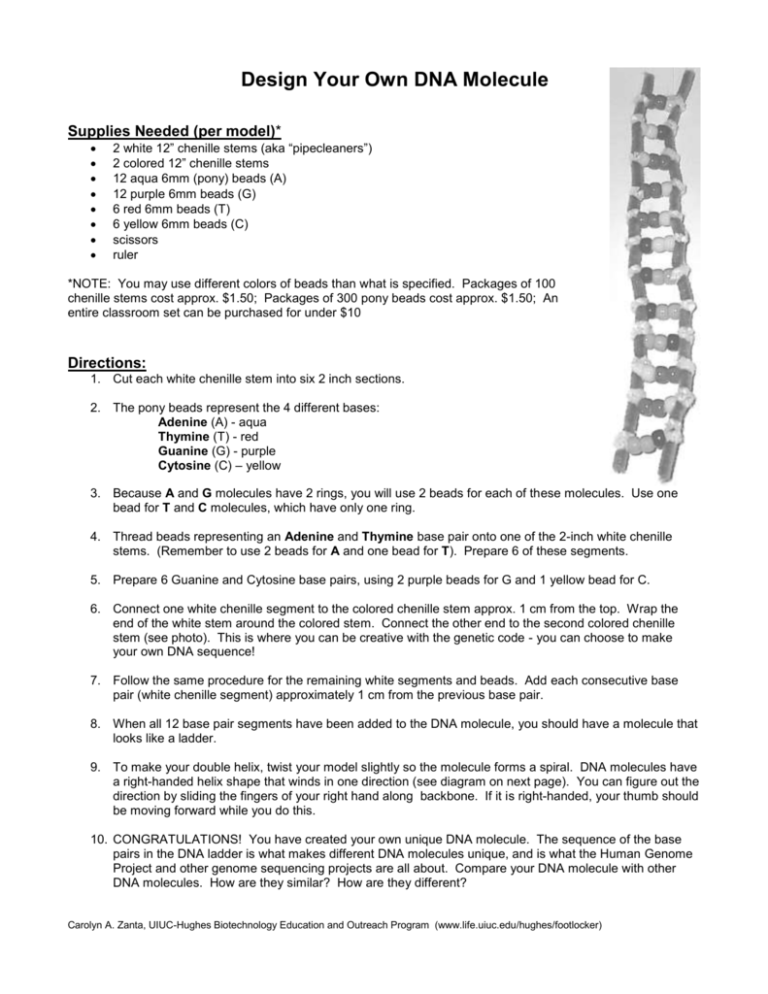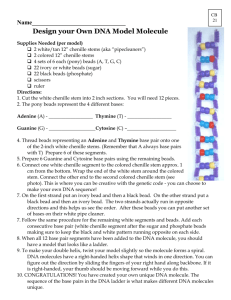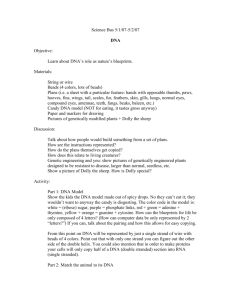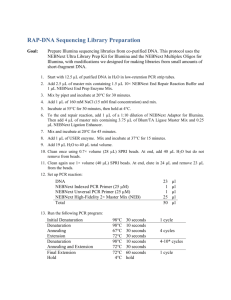Design Your Own DNA Molecule - Oklahoma State 4-H
advertisement

Design Your Own DNA Molecule Supplies Needed (per model)* 2 white 12” chenille stems (aka “pipecleaners”) 2 colored 12” chenille stems 12 aqua 6mm (pony) beads (A) 12 purple 6mm beads (G) 6 red 6mm beads (T) 6 yellow 6mm beads (C) scissors ruler *NOTE: You may use different colors of beads than what is specified. Packages of 100 chenille stems cost approx. $1.50; Packages of 300 pony beads cost approx. $1.50; An entire classroom set can be purchased for under $10 Directions: 1. Cut each white chenille stem into six 2 inch sections. 2. The pony beads represent the 4 different bases: Adenine (A) - aqua Thymine (T) - red Guanine (G) - purple Cytosine (C) – yellow 3. Because A and G molecules have 2 rings, you will use 2 beads for each of these molecules. Use one bead for T and C molecules, which have only one ring. 4. Thread beads representing an Adenine and Thymine base pair onto one of the 2-inch white chenille stems. (Remember to use 2 beads for A and one bead for T). Prepare 6 of these segments. 5. Prepare 6 Guanine and Cytosine base pairs, using 2 purple beads for G and 1 yellow bead for C. 6. Connect one white chenille segment to the colored chenille stem approx. 1 cm from the top. Wrap the end of the white stem around the colored stem. Connect the other end to the second colored chenille stem (see photo). This is where you can be creative with the genetic code - you can choose to make your own DNA sequence! 7. Follow the same procedure for the remaining white segments and beads. Add each consecutive base pair (white chenille segment) approximately 1 cm from the previous base pair. 8. When all 12 base pair segments have been added to the DNA molecule, you should have a molecule that looks like a ladder. 9. To make your double helix, twist your model slightly so the molecule forms a spiral. DNA molecules have a right-handed helix shape that winds in one direction (see diagram on next page). You can figure out the direction by sliding the fingers of your right hand along backbone. If it is right-handed, your thumb should be moving forward while you do this. 10. CONGRATULATIONS! You have created your own unique DNA molecule. The sequence of the base pairs in the DNA ladder is what makes different DNA molecules unique, and is what the Human Genome Project and other genome sequencing projects are all about. Compare your DNA molecule with other DNA molecules. How are they similar? How are they different? Carolyn A. Zanta, UIUC-Hughes Biotechnology Education and Outreach Program (www.life.uiuc.edu/hughes/footlocker) Background Information: DNA DNA = Deoxyribonucleic Acid DNA is made of nucleotides Nucleotides contain a base (A, T, G, or C) + deoxyribose sugar + phosphate The 4 different bases form base pairs: Adenine binds with Thymine Guanine binds with Cytosine The shape of DNA is a double helix with a right-handed spiral turn (like a twisted ladder) with the steps representing the base pairs and the sugar+phosphate backbone as the hand rails. In our model, the colored chenille stems represent the phosphate (P) groups and the white portion that wraps around the colored stems represents the sugar groups (S) (see diagram below). Figure from Access Excellence (www.accessexcellence.org) DNA model with a right-handed helix Carolyn A. Zanta, UIUC-Hughes Biotechnology Education and Outreach Program (www.life.uiuc.edu/hughes/footlocker)








